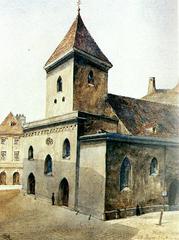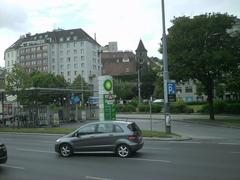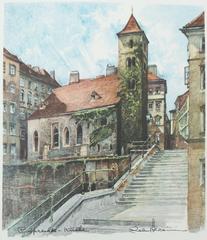
St. Rupert’s Church (Ruprechtskirche), Vienna: Visiting Hours, Tickets, and Historical Significance
Date: 14/06/2025
Introduction
St. Rupert’s Church (Ruprechtskirche) stands as Vienna’s oldest surviving church and one of the most significant symbols of the city’s medieval heritage. Established as early as the 8th century, this remarkable building predates Vienna’s rise as an imperial capital. It is dedicated to St. Rupert of Salzburg, the patron saint of salt merchants, reflecting Vienna’s early economic ties to the salt trade along the Danube. Its enduring presence at the heart of Vienna’s oldest quarter offers a unique blend of religious, social, and architectural history (awaytothecity.com; tourmycountry.com).
Over the centuries, St. Rupert’s Church has evolved architecturally with Romanesque, Gothic, and Baroque influences, and has served as a spiritual and social hub for Vienna’s community. Despite periods of conflict and change, including Ottoman sieges and World War II, the church has withstood the test of time, preserved through careful restoration. Today, it welcomes visitors with free admission, guided tours, and a peaceful atmosphere in the historic city center (SpottingHistory; wien.info).
This comprehensive guide offers a detailed exploration of St. Rupert’s Church’s history, architecture, visitor information, and practical tips to help you plan a memorable visit to this Viennese treasure.
Contents
- Early Origins and Foundation
- Architectural Evolution
- Romanesque Beginnings
- Medieval Modifications
- Baroque and Later Restorations
- Historical and Cultural Significance
- Notable Features and Artifacts
- Visiting Information
- Hours, Admission, Accessibility
- Tours and Events
- Getting There
- Visitor Tips
- Nearby Attractions
- Frequently Asked Questions (FAQ)
- Conclusion
- Sources
Early Origins and Foundation
St. Rupert’s Church is widely recognized as Vienna’s oldest surviving church, with origins possibly dating to the 8th century, although the earliest documented references point to the early 12th century (awaytothecity.com; kulturenvanteri.com). Its dedication to St. Rupert, patron of salt merchants, is closely tied to Vienna’s historical role in the salt trade. The church’s location near the former Roman settlement of Vindobona underlines its foundational significance to the city’s development.
From the Middle Ages, St. Rupert’s was more than a religious site—it was a commercial hub as Vienna’s designated “Salzamt” (salt office), giving it a vital civic role in the city’s economic life (tourmycountry.com; nomadepicureans.com).
Architectural Evolution
Romanesque Beginnings
St. Rupert’s Church is a rare and authentic example of Romanesque architecture in Vienna. Key features include thick stone walls, small arched windows, and a fortress-like tower. Elements of the original Romanesque structure are visible in the nave and the lower tower (SpottingHistory; Virginia Duran).
Medieval Modifications
Following a destructive fire in 1276, the church underwent Gothic renovations, especially to the choir and southern nave, introducing pointed arches and ribbed vaults. These enhancements reflect both the growth of the parish and the shifting architectural styles of the period (SpottingHistory).
Baroque and Later Restorations
In the 17th century, Baroque additions such as gilded altars and stucco were introduced, particularly inside the church. However, the exterior has maintained its medieval character. The 20th century saw careful restoration efforts following minor World War II damage, ensuring the continued preservation of its Romanesque and Gothic elements (SpottingHistory).
Historical and Cultural Significance
Throughout its history, St. Rupert’s Church has played a central role in Vienna’s religious and social life. It hosted baptisms, weddings, funerals, and regular worship for centuries. Its link to the salt trade made it a gathering point for merchants, cementing its place in Vienna’s civic fabric (tourmycountry.com). The church survived fires, invasions (including the Ottoman sieges), and political upheaval, and emerged from World War II with only minor damage—a testament to its resilience (nomadepicureans.com; 365Austria).
Notable Features and Artifacts
- Stained Glass Windows: The apse houses Vienna’s oldest stained glass windows, dating from the late 13th century, with scenes of Christ and the Madonna with Child. Modern stained glass (22 panes) was added in 1933, blending tradition and modernity (tourmycountry.com; SpottingHistory).
- Ancient Bells: St. Rupert’s contains the city’s oldest church bells, cast circa 1280, and still in use today (Wikipedia).
- Relics: The reliquary of St. Vitalis, dressed in Baroque attire, is displayed beneath the north wall gallery and believed to come from the Roman catacombs (365Austria).
- AEIOU Plaque: This cryptic imperial motto of Emperor Frederick III, inscribed with “1439,” commemorates his entrance into Vienna and is visible on the western gallery arch (Wikipedia).
- The Crypt: Beneath the church lies a crypt of uncertain age, rebuilt multiple times and adding an air of mystery to the site (365Austria).
Visiting Information
Hours and Admission
-
Typical visiting hours:
- Tuesday: 13:30 – 16:00
- Wednesday: 13:00 – 16:00
- Thursday: 13:00 – 16:00
Hours may vary for special services—check the official website for updates.
-
Admission: Free. Donations are welcome to support preservation and events.
Accessibility
- The church is mostly wheelchair accessible via ramps at the main entrance. Note that interior steps and uneven floors, especially to the crypt, may restrict full access.
Tours and Events
- Guided tours: Available by arrangement—contact the church for details.
- Concerts: Occasional classical music concerts, especially in summer, are a highlight.
- Worship: Regular parish services on Saturdays at 5 p.m. (6 p.m. in July/August) and Friday evening vigils offer a contemplative experience (VIRC).
Getting There
- Address: Ruprechtsplatz 1, 1010 Vienna, Austria
- Transport:
- U-Bahn: Schwedenplatz (U1, U4) or Stephansplatz (U1, U3) stations
- Tram: Lines 1 and 2 to Schwedenplatz; Line 1 to Salztorbrücke
- Bus: 1A, 2A, and 3A to Hoher Markt, Schwedenplatz, Rotenturmstraße, or Salzgries (Visiting Vienna)
Visitor Tips
- Best time to visit: Weekday afternoons for a peaceful experience and optimal lighting on stained glass.
- Photography: Permitted (no flash), but please be mindful during services.
- Dress code: Modest attire recommended—cover shoulders and remove hats.
- Facilities: No restrooms on-site, but nearby cafés and restaurants offer amenities.
Nearby Attractions
- St. Stephen’s Cathedral – Vienna’s iconic Gothic cathedral, a short walk away.
- Ankeruhr – Famous art nouveau clock, nearby on Hoher Markt.
- Maria am Gestade – Another historic church close by.
- Danube Canal Promenade – Ideal for a scenic stroll.
- Altes Rathaus, Salvatorkapelle, Judenplatz – All within Vienna’s historic core.
- Bermuda Triangle District – Lively area with bars and restaurants (365Austria).
Frequently Asked Questions (FAQ)
Is there an entrance fee?
No, admission is free. Donations are appreciated.
What are the current visiting hours?
Generally Tuesday 13:30–16:00, Wednesday and Thursday 13:00–16:00. Check the official website for updates.
Can I take photos inside?
Yes, but use no flash and respect others’ privacy.
Is the church wheelchair accessible?
Entrance is at street level and accessible, but uneven floors inside may be challenging.
Are guided tours available?
Yes, by prior arrangement with the church.
How do I get there by public transport?
Via U-Bahn (Stephansplatz or Schwedenplatz), tram, or bus. The church is also walkable from central city landmarks.
Visual and Interactive Resources
- High-quality images of the façade, stained-glass windows, AEIOU plaque, and interior (suggested alt text: “St. Rupert’s Church Vienna façade,” “Historic stained-glass windows at Ruprechtskirche”).
- Official virtual tour and map if available.
Conclusion
St. Rupert’s Church stands as a living testament to Vienna’s medieval roots, its spiritual and civic past, and its resilience through centuries of change. With free entry, a peaceful setting, and proximity to major attractions, it is both a tranquil retreat and a fascinating destination for anyone interested in history, architecture, or spiritual reflection. Plan your visit to experience Vienna’s oldest church and discover one of the city’s true historical gems.
Sources and Further Reading
- awaytothecity.com’s guide to Vienna’s famous buildings
- Official Vienna tourism website on St. Rupert’s Church
- SpottingHistory’s article on St. Rupert’s Church
- Virginia Duran’s Vienna Architecture
- Visiting Vienna’s St. Rupert’s Church Guide
- Vienna Sightseeing: 5 Churches You Must See
- 365Austria: The Oldest Church in Vienna
- Tourmycountry.com’s Ruprechtskirche overview
- Nomad Epicureans’ Vienna Walking Tour
- VIRC Sightseeing: St. Rupert’s Church
- Wikipedia: St. Rupert’s Church, Vienna
























































































































































